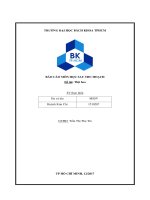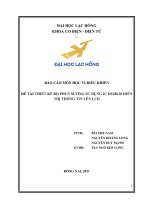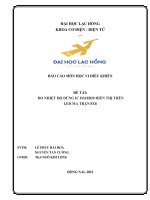BÁO cáo môn học xử lý ẢNH đề tài NHẬN DIỆN ĐEO KHẨU TRANG
Bạn đang xem bản rút gọn của tài liệu. Xem và tải ngay bản đầy đủ của tài liệu tại đây (551.69 KB, 24 trang )
ĐẠI HỌC LẠC HỒNG
KHOA CƠ ĐIỆN ĐIỆN TỬ
BÁO CÁO MÔN HỌC
XỬ LÝ ẢNH
Đề tài
NHẬN DIỆN ĐEO KHẨU TRANG
SVTH: Trương Kim Quốc Bảo
Phạm Minh Tới
Lê Nguyễn Đăng Khoa
LỚP 19DC111
GVHD: T.S Phan Như Quân
Đồng Nai, 5/2022
LỜI MỞ ĐẦU
Mục đích của nhóm em làm đề tài Nhận diện đeo khẩu trang nhằm áp dụng
những kiến thức đã học trên lớp về môn xử lý ảnh do Thầy PHAN NHƯ QUÂN dạy để
áp dụng vào cuộc sống hằng ngày. Giúp thầy cô xử lý điểm số mốt cách nhanh chóng
tránh sai sốt khi xuất điểm .
NHẬN XÉT
(Giáo Viên Hướng Dẫn)
.......................................................................................................................................................................
.......................................................................................................................................................................
.......................................................................................................................................................................
.......................................................................................................................................................................
.......................................................................................................................................................................
.......................................................................................................................................................................
.......................................................................................................................................................................
.......................................................................................................................................................................
.......................................................................................................................................................................
.......................................................................................................................................................................
.......................................................................................................................................................................
.......................................................................................................................................................................
.......................................................................................................................................................................
.......................................................................................................................................................................
LỜI CẢM ƠN
Trong thời gian thực hiện đề tài với nội dung lập trình xử lý ảnh Nhận diện đeo
khẩu trang , chúng em đã cố gắng vận dụng những kiến thức đã học ở trường, cũng như
thực tế. Cùng với sự giúp đỡ của thầy PHAN NHƯ QUÂN, cho tới nay đã hồn thành
u cầu của đề tài. Đó là lâp trình xử lý ảnh Nhận diện đeo khẩu trang và xuất tín hiệu
cảnh báo.
Chúng em xin chân thành cảm ơn thầy PHAN NHƯ QUÂN đã tận tình chỉ bảo và
giúp đỡ em hoàn thành đề tài . Do kiến thức cịn hạn chế trong q trình thực hiện đề tài
nghiên cứu chúng em không tránh khỏi những sai xót mong q thầy cơ trong hội đồng
thi chỉ dẫn, bỏ qua và giúp đỡ em. Chúng em rất mong được sự giúp đỡ của quý thầy cô
và các bạn để nội dung để tài này ngày càng hoàn thiện hơn.
CHƯƠNG 1 : TỔNG QUAN
1.1 Đặt vấn đề
Để đáp ứng được nhu cầu phòng chống dịch covid 19 hiệu quả , nhanh chóng, đặc biệt là
rất an tồn . Để đáp ứng được nhu cầu đó nhóm tụi em đã thơng qua mơn xử lý ảnh để lập
trình nhận diện đeo khẩu trang . Vì thế nên hơm nay nhóm chúng em xin trình bày đề tài
nhận diện đeo khẩu trang thông qua xử lý ảnh trên Python.
1.2 Mục tiêu
Nhằm mục tiêu xây dựng và phát triển đề tài phòng chống ngăn ngừa dịch Covid 19 ,
giúp cộng đồng có thể giảm thiểu căn bệnh này lây lan trên diện rộng.
1.3 Nội dung nghiên cứu
-Tìm hiểu cách thức hoạt động của phần mềm Python
-Thiết kế giao diện để đọc và nhận diện khn mặt có khẩu trang và khơng có khẩu trang
- lập trình trên Python
- Tiến hành báo cáo.
1.4 Bố cục
Chương 1: Tổng Quan
Chương này trình bày đặt vấn đề dẫn nhập lý do chọn đề tài, mục tiêu, nôi dung nghiên
cứu, các giới hạn thông số của báo cáo.
Chương 2: Cơ Sở Lý Thuyết.
Nền tảng lý thuyết quan trọng được trình bày ở chương này, dựa vào đó đề tính tốn và
thiết kế mạch thực tế.
Chương 3: Thiết Kế và Lập trình
Thiết kế giao diện và lập trình cho đề tài
Chương 4: Kết Quả, Nhận Xét và Đánh Giá
Sau khi hồn thành việc lập trình, chương này trình bảy kết quả nghiên cứu và từ đó rút
ra nhận xét, đánh giá.
5
CHƯƠNG 2 CƠ SỞ LÝ THUYẾT
2.1 Tổng quan về xử lý ảnh
Xử lý ảnh (XLA) là đối tuợng nghiên cứu của lĩnh vực thị giác máy, là quá trình
biến đổi từ một ảnh ban đầu sang một ảnh mới với các đặc tính và tuân theo ý
muốn của ngƣời sử dụng. Xử lý ảnh có thể gồm q trình phân tích, phân lớp các
đối tƣợng, làm tăng chất luợng, phân đoạn và tách cạnh, gán nhãn cho vùng hay
quá trình biên dịch các thơng tin hình ảnh của ảnh.
2.2 Hình ảnh kỹ thuật số
Ảnh: Thông tin về vật thể hay quang cảnh được chiếu sáng mà con người quan sát
và cảm nhận bằng mắt và hệ thần kinh thị giác.
• Đối tượng của xử lý ảnh là xử lý các ảnh tự nhiên, ảnh chụp, dữ liệu ảnh có
nguồn gốc từ tín hiệu ảnh đặc trưng bởi biên độ và dải tần số. Có sự phân biệt giữa
xử lý ảnh với đồ họa.
• Hệ thống xử lý ảnh thu nhận khung cảnh hoặc ảnh ở đầu vào, thực hiện các phép
xử lý để tạo ra một ảnh ở đầu ra thỏa mãn các yêu cầu về cảm thụ hoặc trích rút các
đặc trưng của ảnh.
2.3 Phần mềm sử dụng:
2.3.1 : Phần mền Python
Hình 2.3.1: Hình ảnh phần mềm Python
6
Python là một trong những ngơn ngữ lập trình cấp cao hướng tới đối tượng chủ yếu
là những người dùng để phát triển website. Python được ra mắt đầu tiên vào năm
1991 bởi Guido van Rossum.
Nó được thiết kế với ưu điểm là dễ đọc - dễ học - dễ nhớ. Python là ngơn ngữ có
hình thức sáng sủa, có cấu trúc rõ ràng và thuận tiện cho những người mới học lập
trình web.
Các nhà phát triển có thể đọc và dịch mã ngơn ngữ lập trình Python dễ dàng hơn
rất nhiều so với những ngôn ngữ khác. Điều này đã làm giảm đi những chi phí bảo
trì và phát triển chương trình, bởi nó cho phép các nhóm làm việc cộng tác mà
khơng hề có rào cản ngơn ngữ và những kinh nghiệm đáng kể.
2.3.2 Phần mềm chạy kèm Pycharm
Hình 2.3.2: Hình ảnh phần mềm chạy kèm Pycharm
Pycharm có thể chạy trên Windows, Linux, hoặc Mac OS. Ngoài ra, nó cũng chứa
các Mơ đun và các gói giúp các lập trình viên phát triển phần mềm bằng Python
trong thời gian ngắn với ít cơng sức hơn. Hơn nữa, nó cũng có khả năng tùy chỉnh
theo yêu cầu của nhà phát triển.
Pycharm là một giải pháp phù hợp cho Python developers vì IDE này hỗ trợ nhiều
extensions, mơi trường ảo (Virtual Environment), nhiều tính năng thơng minh như
bộ code completion, tự động thụt lề, phát hiện văn bản trùng lặp và kiểm tra lỗi.
Ngồi ra cịn có các tính năng tìm kiếm mã nguồn thơng minh để tìm kiếm từng từ
một trong nháy mắt.
7
2.4 . Xử lý hình ảnh với Python
DIRECTORY chức năng được sử dụng để đọc hình ảnh từ tệp đồ họa.
Syntax: A=directory(‘path\name.jpg’); % (png, bmp, tif, jpeg)
CATEGORIES chức năng được sử dụng để nhận diện có khẩu trang hay khơng .
train_test_split hàm được sử dụng để mở hộp thoại tệp, tạo duyệt (hoặc hộp thoại),
cho phép người dùng chọn ảnh.
Syntax: [filename, pathname] = train_test_split ({'*.m';'*.slx';'*.mat';'*.*'},'File
Selector');
2.5 Xác định giá trị của các pixel riêng lẻ trong hình ảnh
hàm os.path.join: khơng có đối số đầu vào, impixel liên kết chính nó với hình ảnh trong
trục hiện tại. Chọn các điểm trên ảnh để đọc giá trị pixel.
*Cách nối chuỗi
img_path (path, filename): nối hai chuỗi với nhau (Chuỗi ghép)
*Cách có được thơng tin của tập tin đồ họa
ImageDataGenerator: (image find information) Filename; FileModDate; FileSize;
Format; FormatVersion; Width; Height; BitDepth; ColorType
8
CHƯƠNG 3 THIẾT KẾ VÀ LẬP TRÌNH
3.1 Thiết kế giao diện
Hình 3.1.1 Hình ảnh giao diện thiết kế hợp lệ
9
Hình 3.1.2 Hình ảnh giao diện thiết kế khơng hợp lệ
Hình 3.1.3 Hình ảnh giao diện thiết kế khơng hợp lệ
10
3.2 Lưu đồ giải thuật
11
Hình 3.2.1 Lưu đồ giải thuật
12
3.3 Lập trình
Code:
Khau trang :
import the_necessary_packages
from tensorflow.keras.applications.mobilenet_v2 import preprocess_input
from tensorflow.keras.preprocessing.image import img_to_array
from tensorflow.keras.models import load_model
from imutils.video import VideoStream
import numpy as np
import imutils
import time
import cv2
import os
def detect_and_predict_mask(frame, faceNet, maskNet):
# grab the dimensions of the frame and then construct a blob
# from it
(h, w) = frame.shape[:2]
blob = cv2.dnn.blobFromImage(frame, 1.0, (224, 224), (104.0, 177.0,
123.0))
# pass the blob through the network and obtain the face detections
faceNet.setInput(blob)
detections = faceNet.forward()
print(detections.shape)
# initialize our list of faces, their corresponding locations,
# and the list of predictions from our face mask network
13
faces = []
locs = []
preds = []
# loop over the detections
for i in range(0, detections.shape[2]):
# extract the confidence (i.e., probability) associated with
# the detection
confidence = detections[0, 0, i, 2]
# filter out weak detections by ensuring the confidence is
# greater than the minimum confidence
if confidence > 0.5:
# compute the (x, y)-coordinates of the bounding box for
# the object
box = detections[0, 0, i, 3:7] * np.array([w, h, w, h])
(startX, startY, endX, endY) = box.astype("int")
# ensure the bounding boxes fall within the dimensions of
# the frame
(startX, startY) = (max(0, startX), max(0, startY))
(endX, endY) = (min(w - 1, endX), min(h - 1, endY))
# extract the face ROI, convert it from BGR to RGB channel
# ordering, resize it to 224x224, and preprocess it
face = frame[startY:endY, startX:endX]
face = cv2.cvtColor(face, cv2.COLOR_BGR2RGB)
face = cv2.resize(face, (224, 224))
face = img_to_array(face)
face = preprocess_input(face)
14
# add the face and bounding boxes to their respective
# lists
faces.append(face)
locs.append((startX, startY, endX, endY))
# only make a predictions if at least one face was detected
if len(faces) > 0:
# for faster inference we'll make batch predictions on all
# faces at the same time rather than one-by-one predictions
# in the above for loop
faces = np.array(faces, dtype="float32")
preds = maskNet.predict(faces, batch_size=32)
# return a 2-tuple of the face locations and their corresponding
# locations
return (locs, preds)
# load our serialized face detector model from disk
prototxtPath = r"face_detector\deploy.prototxt"
weightsPath = r"face_detector\res10_300x300_ssd_iter_140000.caffemodel"
faceNet = cv2.dnn.readNet(prototxtPath, weightsPath)
# load the face mask detector model from disk
maskNet = load_model("mask_detector.model")
# initialize the video stream
print("[INFO] starting video stream...")
vs = VideoStream(src=0).start()
# loop over the frames from the video stream
while True:
15
# grab the frame from the threaded video stream and resize it
# to have a maximum width of 400 pixels
frame = vs.read()
frame = imutils.resize(frame, width=800)
# detect faces in the frame and determine if they are wearing a
# face mask or not
(locs, preds) = detect_and_predict_mask(frame, faceNet, maskNet)
# loop over the detected face locations and their corresponding
# locations
for (box, pred) in zip(locs, preds):
# unpack the bounding box and predictions
(startX, startY, endX, endY) = box
(mask, withoutMask) = pred
# determine the class label and color we'll use to draw
# the bounding box and text
label = "nhan dien khuon mat"
if mask > withoutMask:
print("da deo khau trang")
color = (0, 255, 0)
label = "da deo khau trang"
else:
print("chua deo khau trang")
color = (0, 0, 255)
label = "chua deo khau trang"
# include the probability in the label
# label = "{}: {:.2f}%".format(label, max(mask, withoutMask) * 100)
16
# display the label and bounding box rectangle on the output
# frame
cv2.putText(frame, label, (startX, startY - 10),
cv2.FONT_HERSHEY_SIMPLEX, 0.45, color, 2)
cv2.rectangle(frame, (startX, startY), (endX, endY), color, 2)
# show the output frame
cv2.imshow("Frame", frame)
key = cv2.waitKey(10) & 0xFF
# if the q key was pressed, break from the loop
if key == ord("q"):
break
# do a bit of cleanup
cv2.destroyAllWindows()
vs.stop()
Data :
# import the necessary packages
from tensorflow.keras.preprocessing.image import ImageDataGenerator
from tensorflow.keras.applications import MobileNetV2
from tensorflow.keras.layers import AveragePooling2D
from tensorflow.keras.layers import Dropout
from tensorflow.keras.layers import Flatten
from tensorflow.keras.layers import Dense
from tensorflow.keras.layers import Input
from tensorflow.keras.models import Model
from tensorflow.keras.optimizers import Adam
17
from tensorflow.keras.applications.mobilenet_v2 import preprocess_input
from tensorflow.keras.preprocessing.image import img_to_array
from tensorflow.keras.preprocessing.image import load_img
from tensorflow.keras.utils import to_categorical
from sklearn.preprocessing import LabelBinarizer
from sklearn.model_selection import train_test_split
from sklearn.metrics import classification_report
from imutils import paths
import matplotlib.pyplot as plt
import numpy as np
import os
# initialize the initial learning rate, number of epochs to train for,
# and batch size
INIT_LR = 1e-4
EPOCHS = 20
BS = 32
DIRECTORY = r"C:\Mask Detection\CODE\Face-Mask-Detection-master\dataset"
CATEGORIES = ["with_mask", "without_mask"]
# grab the list of images in our dataset directory, then initialize
# the list of data (i.e., images) and class images
print("[INFO] loading images...")
data = []
labels = []
for category in CATEGORIES:
path = os.path.join(DIRECTORY, category)
for img in os.listdir(path):
img_path = os.path.join(path, img)
18
image = load_img(img_path, target_size=(224, 224))
image = img_to_array(image)
image = preprocess_input(image)
data.append(image)
labels.append(category)
# perform one-hot encoding on the labels
lb = LabelBinarizer()
labels = lb.fit_transform(labels)
labels = to_categorical(labels)
data = np.array(data, dtype="float32")
labels = np.array(labels)
(trainX, testX, trainY, testY) = train_test_split(data, labels, test_size=0.20, stratify=labels,
random_state=42)
# construct the training image generator for data augmentation
aug = ImageDataGenerator(rotation_range=20, zoom_range=0.15,
width_shift_range=0.2, height_shift_range=0.2, shear_range=0.15,
horizontal_flip=True, fill_mode="nearest")
# load the MobileNetV2 network, ensuring the head FC layer sets are
# left off
baseModel = MobileNetV2(weights="imagenet", include_top=False,
input_tensor=Input(shape=(224, 224, 3)))
# construct the head of the model that will be placed on top of the
# the base model
headModel = baseModel.output
headModel = AveragePooling2D(pool_size=(7, 7))(headModel)
headModel = Flatten(name="flatten")(headModel)
headModel = Dense(128, activation="relu")(headModel)
19
headModel = Dropout(0.5)(headModel)
headModel = Dense(2, activation="softmax")(headModel)
# place the head FC model on top of the base model (this will become
# the actual model we will train)
model = Model(inputs=baseModel.input, outputs=headModel)
# loop over all layers in the base model and freeze them so they will
# not be updated during the first training process
for layer in baseModel.layers:
layer.trainable = False
# compile our model
print("[INFO] compiling model...")
opt = Adam(lr=INIT_LR, decay=INIT_LR / EPOCHS)
model.compile(loss="binary_crossentropy", optimizer=opt, metrics=["accuracy"])
# train the head of the network
print("[INFO] training head...")
H = model.fit(aug.flow(trainX, trainY, batch_size=BS), steps_per_epoch=len(trainX) //
BS,
validation_data=(testX, testY), validation_steps=len(testX) // BS,
epochs=EPOCHS)
# make predictions on the testing set
print("[INFO] evaluating network...")
predIdxs = model.predict(testX, batch_size=BS)
# for each image in the testing set we need to find the index of the
# label with corresponding largest predicted probability
predIdxs = np.argmax(predIdxs, axis=1)
# show a nicely formatted classification report
print(classification_report(testY.argmax(axis=1), predIdxs, target_names=lb.classes_))
# serialize the model to disk
20









